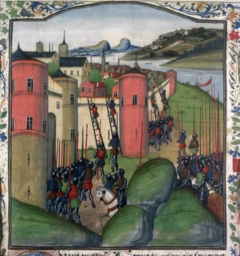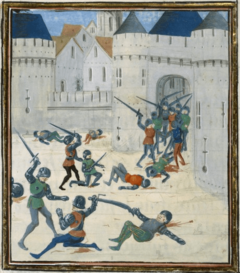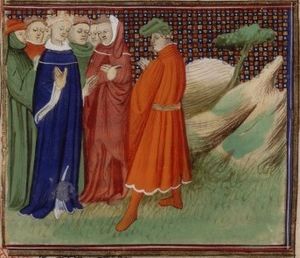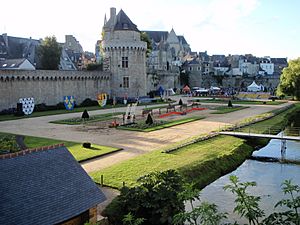Sieges of Vannes (1342) facts for kids
Quick facts for kids Siege of Vannes |
|||||||
|---|---|---|---|---|---|---|---|
| Part of the War of the Breton Succession | |||||||
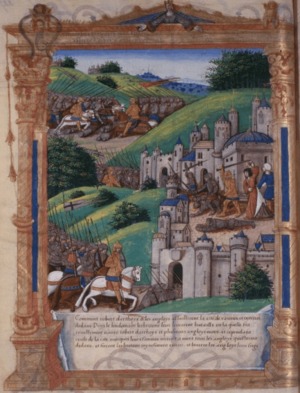 Siege of Vannes in 1342 by Guillaume Fillastre |
|||||||
|
|||||||
| Belligerents | |||||||
| Party of Montfort: |
Party of Blois: |
||||||
| Commanders and leaders | |||||||
| Casualties and losses | |||||||
| Unknown | Unknown | ||||||
The sieges of Vannes of 1342 were a series of four attacks on the town of Vannes during the year 1342. These attacks happened because two people, John of Montfort and Charles of Blois, were fighting over who should rule Brittany. This fight was part of a bigger war called the War of the Breton Succession, which lasted from 1341 to 1365. The many sieges badly damaged Vannes and the land around it. Eventually, a peace agreement called the Truce of Malestroit was signed in January 1343. Vannes was given to special representatives from the Pope. It ended up under English control from 1343 until the war ended in 1365.
Contents
Why the Sieges Happened
Brittany was a special area in France, almost like its own country. It had strong connections with England, especially for trade like salt. For a long time, powerful families, including English kings, tried to control Brittany. This led to many arguments over who was truly in charge.
Who Wanted to Rule Brittany?
The Duke of Brittany, John III, died on April 30, 1341. He didn't have any children or a will to say who should take over. This caused a big problem!
Two main people claimed they should be the next Duke:
- Charles de Blois: He was married to John III's niece, Jeanne de Penthievre.
- Jean de Montfort: He was John III's half-brother.
At the same time, the Kingdom of France was fighting the Hundred Years' War against England. So, Charles de Blois teamed up with the French King, and Jean de Montfort allied with the English King. Jean de Montfort quickly took control of some important places in Brittany, like Nantes. Vannes decided to support him.
Vannes Under Attack in 1342
First Attack
Early in 1342, Charles de Blois arrived at Vannes with his army. They attacked and destroyed parts of the town outside the main walls. The leaders of Vannes decided to give up the city to Charles. Geoffrey of Malestroit, who was in charge of Vannes for Jean de Montfort, managed to escape. Charles de Blois entered Vannes but only stayed for five days before leaving.
Second Attack
In October, Robert III d'Artois arrived near Vannes with about 10,000 soldiers. At the same time, Joanna of Flanders (Jean de Montfort's wife) and other leaders joined him.
They attacked Vannes from three sides. The defenders, led by Olivier IV de Clisson, fought back hard. During the night, Robert d'Artois and William Montagu created a distraction at two of Vannes' gates. While the city's defenders rushed there, a small group led by Walter Manny attacked a different part of the wall that was left unguarded. They made a lot of noise, making it seem like the city was being taken over. The defenders were caught by surprise. Some escaped, but many were killed. Vannes was now back under the control of Jean de Montfort's side.
After Vannes was captured, Joanna of Flanders arrived. She stayed for five days, then left Robert d'Artois in charge of the English and Breton soldiers.
Third Attack
Clisson was very angry that Vannes had been lost. He gathered about 12,600 men and headed back to Vannes in November. Robert d'Artois didn't have enough time to get more soldiers.
He couldn't stop Clisson's army. Troops from Charles de Blois's side entered Vannes through holes in the walls that hadn't been fixed from the last attack. Vannes was attacked and looted again. During this siege, Robert d'Artois was badly wounded. He was taken to London for treatment but died later from his injuries. Vannes was now back under the control of Charles de Blois.
Fourth Attack
When Edward III of England heard that Vannes was lost and Robert d'Artois was wounded, he decided to get revenge. He went to Brittany himself and started attacking three towns: Rennes, Vannes, and Nantes.
The French navy tried to stop English ships carrying supplies. Edward III had to spread out his fleet to save it. All the English efforts then focused on Vannes. The siege began on December 5, 1342. Edward III called Vannes "the best city in Brittany after Nantes... on the sea and well defended." He launched a big attack, but the defenders fought for six hours and held strong.
The English settled in for a long siege and began to steal from the areas around Vannes. During one of the daily fights outside the city, Clisson was captured by the English. On the English side, Ralph, Earl of Stafford, was also captured by the defenders of Vannes.
Meanwhile, Philip VI of France gathered a huge army of 50,000 men. This army, led by his son John II, moved into Brittany.
The Pope Steps In
Two special messengers from Pope Clement VI arrived. They helped stop a big battle between the two armies. They arranged a three-year peace agreement called the Truce of Malestroit, which was signed on January 19, 1343. The attack on Vannes was stopped, and the city was temporarily given to the Pope's messengers.
What Happened After the Sieges
According to the peace treaty, Vannes was given to the Pope's representatives, who put their own governors in charge. The French King believed the treaty meant Charles de Blois should be the Duke of Brittany. So, the Pope's messengers planned to give Vannes back to the King of France.
English Control
However, the people of Vannes and the local church leaders were loyal to Jean de Montfort. A few months after the treaty, they kicked out the Pope's agents. English soldiers then took control of Vannes in September 1343. They stayed there for the next twenty years, until another peace treaty was signed in 1365.
Being under English control slowed down Vannes' growth. The villages and countryside around it had been destroyed by all the sieges. It was hard to rebuild while the war continued. Still, Vannes benefited from England's power in France and traded a lot with English-controlled ports. The town council also gained more power and could send representatives to important meetings.
After 1365, under the new Duke John IV, Vannes began to get back on its feet. The damage from the war was still clear. The Duke decided to rebuild the destroyed walls, fix the gates, and make the town walls bigger. He also built a new home for himself, the castle of l'Hermine, in Vannes. For many years, Vannes became the main center of power for the Duke of Brittany.
The Sad Story of Olivier IV de Clisson
Olivier IV de Clisson was a military leader for Charles de Blois and the King of France. He was captured by the English during the fourth siege of Vannes in 1342. He was later set free for a surprisingly small amount of money. Because of this, the French King and his advisors thought Clisson might have secretly worked with the English King.
Clisson was tricked into going to Paris. On August 2, 1343, he was executed by beheading on the French King's orders. This quick execution shocked many nobles because his guilt wasn't clearly proven in public. The King made the decision without a proper trial. Also, nobles at the time felt they had the right to choose who they supported without being called traitors.
After his death, Clisson's body was treated very badly. This was usually done to the worst criminals. His body was hung in Paris, and his head was displayed on a gate in Nantes.
Clisson's widow, Jeanne de Belleville, was furious. She told her sons, Olivier and Guillaume, to get revenge for their father. Many lords in Brittany supported her. She used her money to raise an army and attack French bases in Brittany. She even armed two ships and, with her sons, attacked French ships at sea. This fight ended when French warships captured her ships. Jeanne managed to escape with her two sons in a small boat. Sadly, after five days adrift, Guillaume died from thirst, cold, and tiredness. Olivier and his mother were eventually rescued and taken to Morlaix by people who supported Jean de Montfort.


